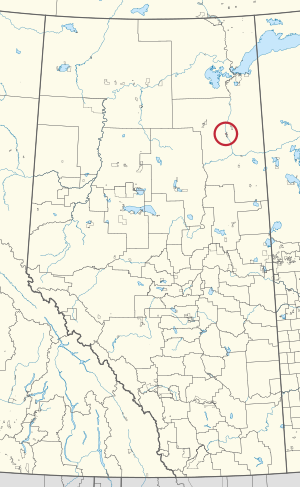Fort McKay 174D facts for kids
Quick facts for kids
Fort McKay 174D
|
|
|---|---|
| Fort McKay Indian Reserve No. 174D | |

Location in Alberta
|
|
| First Nation | Fort McKay |
| Treaty | 8 |
| Country | Canada |
| Province | Alberta |
| Specialized municipality | Wood Buffalo |
| Area | |
| • Total | 660.8 ha (1,632.9 acre) |
Fort McKay 174D is an Indian reserve located in Alberta, Canada. It is a special piece of land set aside for the Fort McKay First Nation. This reserve is found within the larger Regional Municipality of Wood Buffalo.
Contents
What is Fort McKay 174D?
Fort McKay 174D is one of the lands that belong to the Fort McKay First Nation. An Indian reserve is a specific area of land in Canada. These lands are legally set aside for the use and benefit of First Nations communities. The Fort McKay First Nation manages this reserve.
Where is Fort McKay 174D Located?
This reserve is in the province of Alberta, Canada. It is part of the Regional Municipality of Wood Buffalo. This municipality is a large area in northeastern Alberta. It includes the city of Fort McMurray and many smaller communities. The reserve covers about 660.8 hectares (which is about 1,633 acres).
Who are the Fort McKay First Nation?
The Fort McKay First Nation is an Indigenous community in Canada. They are part of the Dene and Cree nations. Their traditional territory is in northeastern Alberta. The people of Fort McKay have lived in this area for thousands of years. They have a rich history and culture.
Understanding First Nations and Treaties
First Nations are the original inhabitants of Canada. They have their own unique cultures, languages, and histories. The Fort McKay First Nation is one of many First Nations across Canada.
Many years ago, First Nations signed agreements called Treaties with the Canadian government. These treaties were meant to share the land and resources. Fort McKay First Nation is a signatory to Treaty 8. This means they are part of the agreement made in 1899. Treaties are important documents that guide the relationship between First Nations and Canada. They help protect the rights and lands of Indigenous peoples.

